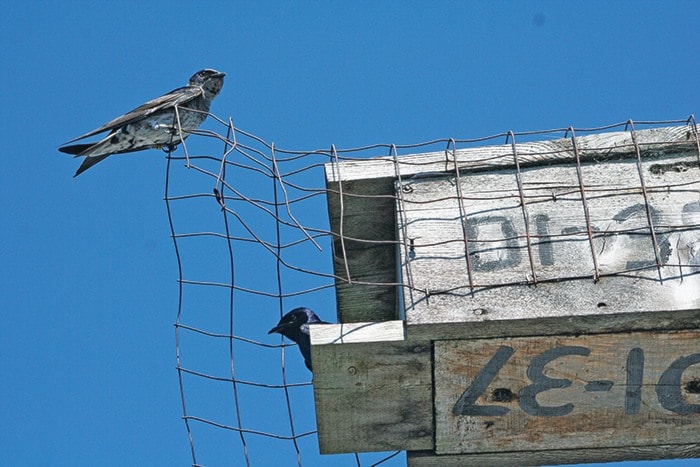The Purple Martin population in B.C. continues to grow, and it’s time to celebrate.
Wear something purple on Sunday, July 21 and join the BC Purple Martin Stewardship and Recovery Program at its ninth annual open house from 3-5 p.m. at the Ladysmith Maritime Society Community Marina.
The Western Purple Martin is a Species At Risk in B.C., and the population in B.C. has increased from five breeding pairs in 1985 to about 800 nesting pairs in 2012, mainly as a result of nest boxes built, installed and maintained by volunteers. The warm dry summer last year and a plentiful supply of flying insects resulted in the martins successfully raising more than 2,800 young, which is a significant increase over recent years, according to a press release.
“Although the final count for 2013 is not yet available, there has been an exceptional return of first-year birds (subadults) this year. Many small- to medium-sized Central Island colonies are again fully occupied, and some are overflowing, which is very exciting to see,” said program biologist Bruce Cousens. “The martin colony at the LMS Marina is the largest on Vancouver Island, and we’re expecting over 60 pairs this year.”
The Purple Martin population in B.C. had fallen to being almost non-existent by the late 1980s because the birds were losing their natural nesting habitat, explained Charlene Lee, administrator of the Georgia Basin Ecological Assessment and Restoration Society (GBEARS) in Nanaimo, which co-ordinates the BC Purple Martin Stewardship and Recovery Program.
“People at that time noticed there were some Purple Martins nesting in woodpecker cavities in old pilings in Cowichan Bay and Victoria Harbour,” she said.
A group of people from the provincial government and naturalists started building nest boxes and putting them up in these areas hoping that the birds would take to the nest boxes and have babies, and then they started putting up boxes at a few other locations, explained Lee.
Now, there are Purple Martin nesting boxes at 70 marine piling areas and 20 freshwater sites from Victoria to Campbell River on the east side of Vancouver Island and also in Powell River, Sechelt and Vancouver and the Lower Mainland.
“It took quite a few years before the numbers picked up, but there’s been a slow and steady increase in the population,” said Lee. “In 2003, 2004 and 2005, we had really good summer weather. Purple Martins feed on large insects like dragonflies, beetles, moths and flying ants, and when the weather is really good, they have a lot of food and they lay a lot of eggs. The weather stayed good, and they were able to feed their babies. From 2003 to 2006, the population tripled from 200 pairs to 600 pairs.”
Then came a few years where the weather in June was pretty poor, and there was one year where the population numbers went down, noted Lee.
“The last couple of years, although the summers haven’t been great, they’ve been good enough that the numbers are back up,” she said.
During Sunday’s open house, visitors will be able to watch adults feeding nestlings, learn more about the conservation of Purple Martins at the displays and hear stories about Purple Martin activities around the Strait of Georgia and other parts of Canada. Martin nestlings will be banded during the open house at 4 p.m.
Light refreshments and the famous purple (blueberry) milkshakes will be served while quantities last.
The open house is an education outreach and a celebration, explained Lee.
“We have a lot of people we see when we’re at our nest box colonies who ask a lot of really good questions about Purple Martins and what we’re doing, and we try to have one day during the season so we can say ‘come visit us and see what we’re doing,’” she said. “We also make it a celebration of how well Purple Martins are doing and try to get people enthusiastic about the program.”
Lee says there are usually 75 to 100 people at the open house, and many people bring their children.
“We have actual banding going on, so they can see and actually hold a baby bird — that’s pretty special for children,” she said.
